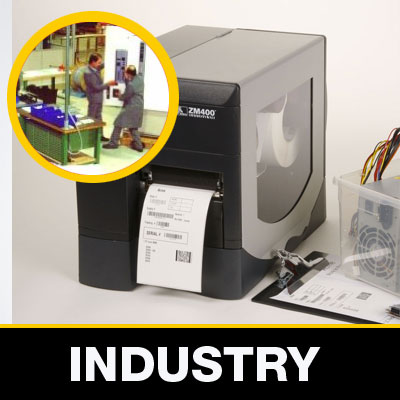Enjoy benefits and new preview !

Otis a lift manufacturer
Based in Gien, France, that has international brand recognition for the 8,000 lift cabin systems and 150,000 lift doors it produces per year. To improve the management of the depot at its distribution centre, Otis has implemented a labelling and bar coding system to help optimise storage capacity, to enable package traceability and to eliminate manual data entry. The new system also enables Otis to offer online access to information for more reliable product delivery. A selection of Zebra Technologies bar code printers is deployed in the new system.
Life in a Global Distribution Centre
Otis’s Gien-based manufacturing plant has been in existence since 1961. The site comprises several operations including cabin system manufacturing; door system manufacturing, for which the Gien site is the world’s leading production centre; a research centre employing 100 people; and a distribution centre. The distribution centre presented the greatest problems in terms of depot management. Due to the size and layout of the site and the complexity of procedures that had developed over time it was very difficult for staff to track and follow up incoming and outgoing consignments. Available storage was inadequately utilised, being determined largely by what space was available in the warehouse. On top of that a significant proportion of data entry was done manually. The reliance on paperwork distributed throughout the process increased the number of errors that arose. Paperwork was produced to assist in information sharing between forklift truck operators for storage, and administrators for data entry.
Product Identification
Even though there is a catalogue of standard equipment, a lift is almost always manufactured to bespoke requirements. Components from two different orders cannot be switched, even if they are identical, so errors of labelling, handwriting, data entry, reading the order number or storage location could lead to packages being misplaced or overlooked which has a potential knock- on effect for quality and delivery times for the customer.
Until Spring 2000, operators at the end of the production lines at Otis identified packages manually, detailing information on the project number, the number of packages and the weight. The distribution centre was organised around a production management and commercial management software package that did not allow for true tracking and tracing, or for storage optimisation.
Otis began the search for a solution to give systematic identification, by product line or by supplier, of all packages passing through the depot. Otis called on IDEM, a specialist integrator in the field of automatic identification and data acquisition, to implement the new equipment. They used 3I for the warehouse management software package and Teklogix for the radio frequency component.
Bar Codes at Otis
IDEM installed 24 Zebra bar code printers at Otis, with a further four for maintenance backup.
A selection of Z4M (Z4000), and S Series (105S and 160S) printers are in continuous use in the door system manufacturing plant, the cabin system manufacturing plant and in the receipt/despatch department. The majority of suppliers to Otis, located across Europe, also use the Zebra label printers.
Commenting on the selection of Zebra printers, Agnes Bassand, head of the organisation project at Otis, said: “Zebra has played a significant role in the field of heat transfer printing globally. The main factors that led to our decision were the user-friendliness and ease of programming, the use of memory for loading tasks, the print size, and the industrial quality of the Z4000 and price compared with any competitors.”
The 105SL and the 160S Zebra printers are robust and reliable printers of metal construction to integrate into the demanding environment of industry and manufacturing. They are generally used for product labelling at the time of delivery and printing on demand. The Z4M printer has a standard print resolution of 203 dpi and has a print speed of up to 254 mm/second.
Labels in Action
The new labelling equipment was specified for component identification at the two manufacturing units at Gien; for the incoming purchase orders department; and in the despatch department. The despatch department makes particular use of the bar codes for storage, order processing, loading, packaging for sea freight, tracking (enabling Otis to assess aspects such as service levels, delays or missing orders), despatch documents and also inventory of finished product stock. The overall project was designed to improve the quality and reliability of data to help provide a higher level of customer service. Storage optimisation was helped by improving awareness of stock levels. Proper package identification assisted in reducing the volume of data entry and the amount of processing each package goes through. Paper-based documentation was eliminated and materials management was greatly improved. Otis was also able to eliminate the annual stock take, replacing it with continuous inventories. Eighty people use the new labelling system at the Gien site. The forklift truck operators were among the first to notice the benefits of the new equipment as they spent so much less time finding relevant packages.
By integrating with the warehouse management software, the bar code printers contribute to the smoother operation of the manufacturing and distribution centres. For example, stock on order can be stored and despatched appropriately when it arrives. Data is immediately available, such as stock lists, stock on order, or lists of purchase orders. Scanning the package bar codes means that the warehouse management system can recommend optimal storage placement, or the location of a package can be verified.
Otis plans to install further Zebra printers on new door production lines where components will be identified by bar code labels at each stage of production. The bar coding process is scheduled for implementation in all of the Otis production sites worldwide spanning the US, Europe, Asia and Australia.
Register to the Newsletter
ZEBRA Technologies
First 100% Zebra online store
The myZebra site is the online sales platform from ECE,
a specialist of Zebra products.
ECE has no tied what so ever to Zebra Technologies Corporation.














